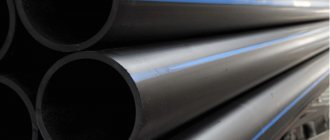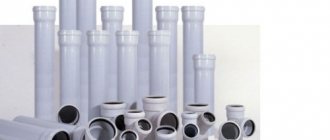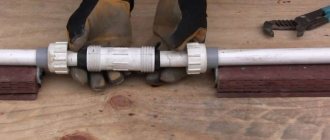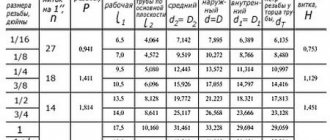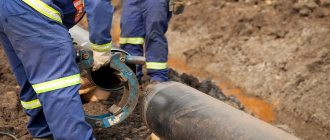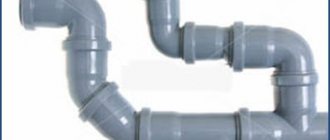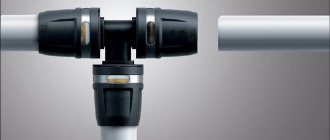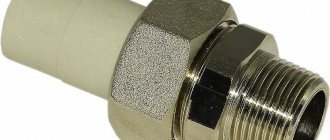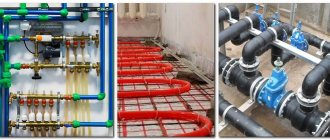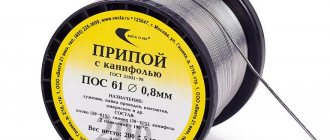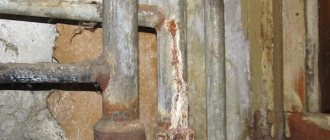Metal pipes are gradually becoming a thing of the past. They are being replaced by various materials; metal-plastic is rightfully considered one of the most popular. Thanks to the successful combination of many advantages, such parts can be used to equip a wide variety of communication systems. They are successfully used in production systems as highways intended for transporting various chemical products. And also in households, where they are used as pipelines for heating systems and for supplying hot water. For installation, special press fittings for metal-plastic pipes are most often used, providing a strong and reliable connection.
- 2 Advantages of permanent connection
- 3 Secrets of proper installation of such parts
3.1 How to choose press pliers?
- 3.2 What to look for when purchasing connectors
- 3.3 Installation secrets from specialists
Press fittings what are they?
There are several types of press fittings, however, they are practically the same.
Any part is constructed from: You can find out the price and buy heating equipment and related products from us. Write, call and come to one of the stores in your city. Delivery throughout the Russian Federation and CIS countries.
- Cases. The type of device depends on this element; it can be made in the form of an angle, tee or coupling. The most common materials used for the body are brass or copper.
- Shells. This is the basic component of the fitting, which is made of stainless steel. The pads of a special tool designed for crimping are mounted on the surface of the sleeve.
- Clips. This piece looks like a ring made of elastic material. The clip is designed to connect the sleeve and the body, and also acts as a gasket that protects the connection from the spread of galvanic currents.
Valtec one-piece press fitting device
Advantages
The bar for the mixer is polypropylene.
The nozzles can have both internal and external threads. Thanks to the unified dimensions, it is possible to connect metal-plastic parts to the copper sections of the mains. Provided that the fittings are installed correctly, it is possible to ensure a very high-quality permanent connection. It is distinguished by its mechanical strength (at the joining points, the working pressure easily reaches 10 atm without any risk to the part). Long-term use of the fitting is another advantage.
Manufacturers most often provide a 50-year guarantee, but only if all manipulations with the product comply with technological standards. The compression fitting is better than other designs also because it does not require mandatory supervision and maintenance. This is very good when hidden lines are installed or concrete is poured. Such connections do not lose their practical advantages even with thermal expansion. Therefore, they can be safely used even in heating systems and in DHW circuits; this will not cause any problems for the consumer.
The installation itself is easy and quick, eliminating the need to master specific tools or special training. Such manipulations are accessible even to beginners; the only tools they will need are crimping pliers. By using fittings, you can reduce the total number of pipes and additional fittings. Therefore, the total costs of installing a water supply or heating system are lower. The general coincidence of the terms of use of the fitting and the metal-plastic pipeline allows them to synchronize their repair and replacement.
Even where there is a very strong corrosive environment, press fittings are guaranteed to withstand. They retain this property throughout the entire operational period. The developers were able to achieve their optimal use for the circulation of both cold and very hot (by domestic standards) water.
Tips for choosing
The reliability of engineering metal-plastic systems in your home or apartment depends on the choice of quality products. Any significant leakage of cold, and even more so hot water will lead to wetting of the covering and structures of the floor, ceiling and, possibly, the ceiling and walls (including those of neighbors). Therefore, you need to choose reliable connectors, in a large store, with a receipt and certificate. There are many manufacturers of fittings, including in every region of Russia. It’s still worth choosing the best (see below).
Before purchasing, you should carefully inspect the product, including the threads. There should be no jams, chips, nicks, or changes in geometric shape. In the markets, you can occasionally find counterfeits made of aluminum or its alloys - they can be distinguished by their weight; aluminum is several times lighter than brass and stainless steel. Markings should be engraved and not painted.
When choosing a material, you should not focus on stainless steel - brass is perfect for household systems. But uncoated brass will tarnish, so it is better to choose brass with chromium-nickel coating.
Best manufacturers and approximate price
The most famous manufacturers of press fittings for metal-plastic pipes: REHAU, PRANDELLI, VALTEC, OVENTROP, Tiemme, COMAP (France), ALTSTREAM (Russia), Henco (Belgium), UPONOR (Finland). Prices for VALTEC products start at 60 rubles (diameter 16 mm, wall thickness 2 mm), often fittings cost 150-200 rubles.
Installation technology
| Types of installation | Technology | Peculiarities |
| Compression installation | After preparing the pipes of the required size, threaded connecting nuts and a split ring are put on their ends, after which the fitting is inserted. Using a wrench, the connection is secured. | Suitable for supplying buildings with cold and hot water, as well as for heating systems. |
| Installation using special press fittings. | A ring-shaped press sleeve is attached to the end of the pipe. An expander is then inserted into the pipe to increase the diameter to the required size in order to push the pipe onto the fitting all the way. A press sleeve is placed on top of the connection, due to which, after a certain period of time, the pipe returns to its original shape before expansion and tightly compresses the fitting. | High strength connection that forms a seamless monolithic connection. It will not be possible to dismantle for subsequent installation of the pipeline system. |
| Installation using electric welding. | A welding coupling is put on the cut with terminals to which a welding machine is connected, with the help of which the pipe and coupling are heated to 170°C. After cooling, a seam forms. | A welded connection requires special equipment and at least basic welding skills. Suitable for pipes with operating pressure up to 12 atm. |
7 tips on which cross-linked polyethylene pipes for underfloor heating, heating and water supply are best to choose
Compressive tension
This is the easiest way to connect. To make such a connection, you do not need a special tool for press fittings; pipe cutting scissors, a calibrator (rolling tool) and a simple adjustable wrench are sufficient, and, moreover, no special work experience is required. You just:
- put on the tension nut and clamping ring;
- after this, insert the fitting onto the rolled edge of the product;
- pull the ring onto it;
- tighten the tension nut with a wrench.
The main problem with such a connection appears in the future. Due to periodic thermal expansion, the threaded connection has a certain movement and the tension weakens.
As a result, a leak may occur, which will lead to corrosion of the metal and its complete destruction. The long-term reliability of such a connection cannot be guaranteed.
Installation
Review of plastic ball valves for polyethylene PVC and HDPE pipes
Fittings made from the material in question can be of different shapes. Popular are corners (bends), plugs, crosses, tees.
Based on the installation principle, we can distinguish compression fittings for cross-linked polyethylene and press fittings. They can make detachable and permanent connections, respectively.
Have you decided to use cross-linked polyethylene as the main material when installing your heating system? Then fittings and pipes should be used from the same manufacturer. Otherwise, products from different manufacturers may not be suitable for each other. And although you may not notice the difference at first glance, leaks may appear during operation.
Installing compression fittings
It is worth saying that these elements are a collapsible structure. To prevent leaks from occurring, the plastic liner is compressed using the union nut.
Installation of compression fittings is carried out without special equipment as follows:
- First, you need to cut the edge of the pipe by at least 5 cm. This is done because the pipe end made of SP may lose some of its performance properties during long-term storage.
- You can cut the product with a grinder or a simple hacksaw for metal. The cutting line must be perpendicular to the longitudinal axis of the pipe. The end needs to be chamfered, which will make it easier to install the water supply. There should be no hangnails. If necessary, you can use sandpaper to remove rough edges.
- A union nut and sleeve are installed on the pipe, and sometimes a backup seal ring is also used. The ring is mounted at the end of the connection segment.
- Now the pipe is inserted into the fitting and the union nut is attached. To ensure a tight seal, it will be enough to tighten everything by hand. If necessary, you can take an adjustable wrench, but in this case do not use excessive force.
Compression fitting for PEX pipes 20x2.0x3/4 STOUT
Installation of press fittings
Such products are installed a little differently. Press fittings imply permanent connections that are characterized by high strength and long service life. Therefore, they can be used when installing high pressure systems.
Expansion Tool for PEX Pipe
Installation is carried out in stages:
- First, the pipes are prepared. The same as when installing compression type fittings.
- An uncut sleeve is attached to the pipe.
- To install, you need to make the pipe edges a little wider. This can be done using a special expander and the necessary attachment.
- The expander handles are brought together and secured in this position for a couple of seconds.
- Then the device is taken out, and the connection fitting is placed in the pipe. Since the material is elastic, the SP pipe tends to take its previous shape and tightly compresses the surface of the fitting - and after a short time it is almost impossible to remove the element.
- The sleeve takes up its working position - it moves onto the pipe above the connecting fitting of the fitting.
- At the final stage, the sleeve is crimped using special press equipment.
Press fitting tee Valtec
https://youtube.com/watch?v=XhNKqi2-tHM
As you have seen, installing cross-linked polyethylene fittings in any case is not difficult, so even a beginner can do it.
Professionals advise when purchasing fittings and pipes made of cross-linked polyethylene to consider the Rehau company. The products from this manufacturer are high quality and have a long service life. However, products from other popular manufacturers are often not inferior in quality characteristics, and some models may cost you even less.
Cross-linked polyethylene is currently the best material for laying water pipes, and compression fittings are the best solution for good sealing of pipe joints. Compared to other products, copper or plastic, the SP system is characterized by high quality and practicality in installation. The high price for fittings for cross-linked polyethylene quickly pays off with resistance to wear and a long service life.
Varieties
Today, the market offers a wide variety of press fitting connections for metal-plastic, cross-linked polyethylene, steel and copper pipes.
One-piece. Installation of this type of fittings involves the use of a microprocessor-controlled hydraulic press machine. The manual analogue of this device is press pliers.
Connecting metal-plastic pipes using one-piece press fittings
In turn, one-piece press fittings are divided into the following types:
- tees;
- corners;
- couplings.
Using any of these parts, you can connect two sections, for example, of metal-plastic pipes. The end result is a strong connection.
The installation process of press fittings consists of the following steps:
- Initially, you need to process the ends of the pipe;
- then put a crimp sleeve on one end of it;
- insert the fitting;
- and the final stage: using a special tool you need to crimp the coupling.
Once dismantled, press fittings are not suitable for reuse.
Compression. The main advantage of such fittings is their simple installation. In addition, such connections are very reliable and durable. After dismantling, compression press fittings can be used repeatedly.
Fittings belonging to this type are constructed from: a fitting, a ferrule, a union nut.
Compression press fitting for copper pipes LUXOR TR 91/AC 15 mm
Installation of compression press fittings:
- First you must decide on the length of the pipe. To do this, you need to measure the area where it will be located, add 10 cm to the resulting value and cut the pipe.
- Afterwards you need to treat the pipes with a calibrator. This way you will prepare the edges of the pipe for installing the fitting.
- Cut rings and nuts are put on the pipe.
- After this, the fitting must be lubricated with silicone material in order to put on the pipe.
- And the final touch is to tighten the nut and tighten it with a wrench.
In the event of a breakdown, the compression fittings do not need to be completely replaced - just remove the worn part of the device and install a new one.
Axial fitting with sliding sleeve PRO AQUA for connecting PE-X and PE-RT pipes
Collet. This type of connection is the most expensive. The high price is explained by the fact that the connection can be assembled and disassembled as many times as desired. Push-in fittings are used to construct a heating system and supply both hot and cold water. They consist not only of threads, but also of a special sealing ring - a collet, which ensures the tightness of the connection between the two pipes.
The structure of a collet fitting: a ferrule, a main part made of brass, and a rubber seal.
Collet press fitting device
Detachable collet connections include: crosses, adapters, tees and other parts.
It is worth noting that not only collet fittings, but also compression fittings can act as tees. Using such connections, any branch can be made in the system. According to the manufacturing method, they can be conventional or combined. The latter, in turn, are divided into products with: external thread, internal thread, union nut.
The cross is similar to a tee. Using it, you can create two branches at once on one pipeline.
Installation of collet press fittings:
- Preliminary marking of places for installing parts on pipes is made;
- Using a pipe cutter or special scissors, you need to cut off the required length of the pipe, its edges must be cleaned of irregularities and burrs;
- then the ring and nut are removed from the fitting and put on the prepared part of the pipe;
- a pipe is installed on the fitting fitting, then it is aligned, and the ferrule returns to its place;
- The nuts are tightened by hand and then tightened with a wrench.
The main disadvantage of using collet fittings is that you will have to periodically check whether the nut is loose and, if necessary, tighten it with a wrench.
Press-on method
The most correct method for installing cross-linked plastic pipes, which takes full advantage of the material’s qualities such as flexibility and molecular memory. When working, put a sleeve on the pipe and press the fitting into the pipe hole.
The connection is distinguished by the highest degree of sealing, in contrast to the methods discussed above, and ensures high reliability of the pipeline. The technology consists of flaring the pipe edge, after which a compression-type fitting is inserted into it. It is fastened using a metal sleeve, which is pulled from above onto the pipe at the location of the fitting.
Rice. 9 Compression method of connecting PE-X pipes
How to level a piece of metal-plastic pipe
Metal-plastic pipes can be easily aligned manually by placing two thumbs connected together at the bottom of the pipe and smoothly bending it with your hands, resting it on the surface of the finger arch.
A more reliable method of bending is the use of spring pipe benders, which are located both inside the pipe and on its surface; bending is also done using physical force of the hands.
Rice. 14 Bending MP pipe
The main methods of installing fittings for MP pipes are pressing and crimping; modern push connections have not yet gained popularity and widespread use in the construction industry. When installing a water supply system, pressed lines, as the most reliable in terms of connection method, are usually placed in the walls, and crimp lines are installed on the surface, so that if the union nut is loosened, it can be slightly tightened after 7-10 years.
How to choose a good fitting and install it
The markings on the case will tell a lot to the connoisseur. Those companies that make high-quality docking elements simply will not use cheap printed fixtures. Therefore, any inscription, even a single symbol, is printed clearly and expressively, excluding the slightest vagueness or misinterpretation
It is equally important to evaluate the weight of the structures, since normal fittings are made from selected brass. If someone tries to claim that lightweight products are just as valuable, this is just a clever marketing ploy or some kind of misunderstanding
It is worth taking a closer look at the appearance of the fitting. If it is made of a thin layer of metal, it will not be possible to obtain a reliable joint. Professionals confidently say that by purchasing cheap elements from small retail outlets, especially those operating unofficially, people doom themselves to re-laying the pipeline. In this regard, investing in a high-quality and expensive variety of components is more than justified.
Using a gauge, the ovality that inevitably occurs during the cut is corrected. Following this, the inside is chamfered using a chamfer remover or a sharp knife. If you use a simple knife, you will still have to refine the desired area with sandpaper. Only when all this has been done can you thread the fitting onto the pipe, making sure to check whether it is seated tightly. There are models that do not require fastening of crimp couplings. Then these same couplings are placed on the pipe and a fitting is inserted into the part, on top of which sealing rings are fixed. At the points of contact between a metal-plastic pipe and a metal element, an insulating gasket is required to protect against electrochemical corrosion.
When connecting fittings of various designs, the sleeve is captured in a clamp and brought together until the handles stop. When the work is done well, the metal part becomes arched, and the fitting receives a pair of identical strips in the shape of a ring. Processing must be completed in one go. The crimping should not be repeated. This will only cause damage to the connection, so the defect will be irreversible. Therefore, you should prepare for work carefully and take into account all the smallest nuances, freeing up time so that nothing interferes.
Such connections, if done properly, can be of no less quality than when using welding - and their tightness satisfies all requirements. It is recommended to use fittings of the same brand as the pipes being connected. If the choice has not yet been made, you can safely use designs from Henko, Valtec. The products of these concerns are of high quality and are very popular. It is easy to use such parts even for beginners.
The fitting for a steel pipeline does not have a fitting; it is just a sleeve itself, which is crimped with pliers. An attempt to compress a metal-plastic pipe without a softening “intermediary” will end in its deformation.
In the next video you will see the principle of working with press fittings for Valtec stainless pipes.
What tool can be used
The selection of special pliers includes both the simplest manual and more powerful hydraulic models. At home, when it is necessary to install or repair a pipeline only occasionally, the functionality of a manual design is quite sufficient. In terms of the quality of the joint created, if everything is done correctly and carefully, there will be no difference from professional devices
It is important to consider that all models are optimized for a specific diameter. There are tools that come with inserts
Then a lot depends on what set of inserts are supplied. Along with the simplest press tongs, there are also more advanced designs. So, if a tool is marked with the letters APC, this means that the device automatically monitors the reliability of the joint being formed. It is impossible to open the press until crimping is completed. The APS marking indicates that the pliers can not only adapt to different sizes of fittings, but also distribute the applied forces most accurately. But if OPS is written on the pliers, then the tool is equipped with stepped clamps and is therefore capable of multiplying the applied force.
Advantages of press fittings
By performing the correct installation of press fittings, you will receive reliable connections that have the following advantages:
- high strength: able to withstand pressure up to 10 atm.;
- long service life: if all installation and operation rules are followed, such connections can last 40-50 years without replacement;
- the connections do not need to be monitored or maintained, so they are well suited for installation when laying hidden pipelines;
- fittings tolerate temperature changes well;
- There are no difficulties during installation;
- These connecting elements are resistant to corrosion.
Straight press fitting
